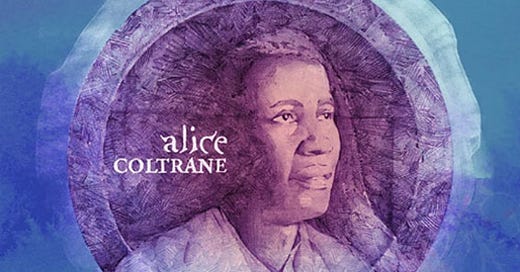Genre of the Day - New Age Kirtan
Album of the Day - Turiya Sings by Alice Coltrane (1982)
The last time kirtan appeared in this column, it was amidst a siege of personal academic stress—as life thrusts me into the hellscape November tends to be in college, it seems the universe knew that I needed a touch of devotional musical remedy yet again. Though this may be my blog, the world doesn’t revolve around me and my stress, and this week tens of millions of Americans are biting their fingers ahead of tomorrow’s presidential election. Mail-in voting may be a blessing, but having to delay results even further only extends our anxious hand-wringing. For millions of people, their personal autonomy and logistical questions like immigration statuses hang in the balance. At present, music can’t really change the course of these sobering, tangible political realities. However, it can certainly serve as a tool to calm and digest these things better, and today’s genre serves exactly that purpose.
Since I already covered kirtan as a genre, I thought today’s genre would give a chance to reflect on new age music as a whole—who knows if it’ll spring up again as the current iteration of this column and the year speeds to their conclusion. New age music began to simmer as the ‘70s saw visionaries try to consolidate various strains of non-western religious philosophy, particularly drawing from Hinduism and emergent international movements from India like ISKCON (International Society for Krishna Consciousness). New age music acted as a calming conduit to spread these ideas in a platform that was procurable and practicable for listeners. New age music reflected the range of the decade’s questioning of traditional religion as well as classical music—other albums harkened back to ideas of verdant pre-Christian Celticism or towards less place-specific ambient, meditative backgrounds. Some new age music probed the outer edges of electronic music up to that point—even if your first instinct is to chalk it up to spa-soundtrack fodder, its feature-length textural explorations were pioneering.
New age kirtan emerged as American musician practitioners of Indian religion, a wave largely unleashed by the Beatles, began experimenting with the traditional devotional genre under a musical framework guided by the artist’s own understanding. Though that could be seen as a curiously American manifestation of individualism, it’s also a testament to the depth of the introspective reaches that kirtan stimulated among these artists. New age kirtan is more spacious and free-range, often backing traditional Sanskrit devotionals with western-leaning melodies and puffing the space with atmospheres common to much of new age music. As yoga became a cultural phenomenon in the ‘90s and popstars flocked to Indian culture, new age kirtan saw a heyday, but musical gurus like Alice Coltrane had been working in the space of fusing avant-garde ambience with the form’s capacity for emotional inspiration for a couple of decades by then. I’ve also been lucky to hear some new age kirtan in real time, as kirtan is traditionally experienced as a call-and-response practice, at my school’s excellent Music Meditation Club.
Alice Coltrane is a musician whose infinite, ‘translinear’ stature is hard to capture with justice given the short nature of this column. Not only was she a preternaturally talented multi-instrumental jazz musician, but a period of deep grief stimulated her spiritual awakening that set the stage for her second act as a musician and human. As she took on the role of spiritual teacher at an ashram near Los Angeles, she took on the Sanskrit name Turiyasangitananda, translating to “the Transcendental Lord’s highest song of bliss.” Her monthly kirtans for the community reflected her persistent belief that music and chanting could be a force for pure love, and the form unlocked new modes of simplicity and ascendance for the visionary. The gentle atmospheric soundscapes of Turiya Sings brought into being by the gently droning organ pulsate as if one is zooming in on and observing the movement of atomic structures while the naked assertions of her voice achieve an unparalleled clarity. You hear the deep reverence she lends each word and her devotion to act as the bridge between listener and these centuries-old mantras. Musically, her improvisational playing as on the dynamic “Yamuna Tira Vihari” runs the gamut between still and stirring, searching for the space in between where a listener can be wholly absorbed and settled yet ablaze within.






Beautiful piece! Looking beyond Turiya Sings, I also have the highest recommendation for World Spirituality Classics Vol. 1: The Ecstatic Music of Alice Coltrane Turiyasangitananda, which Luaka Bop compiled from that and three other cassettes she made while leading the ashram. Amazing stuff.